Rebecca Yahr
Lichenology 101
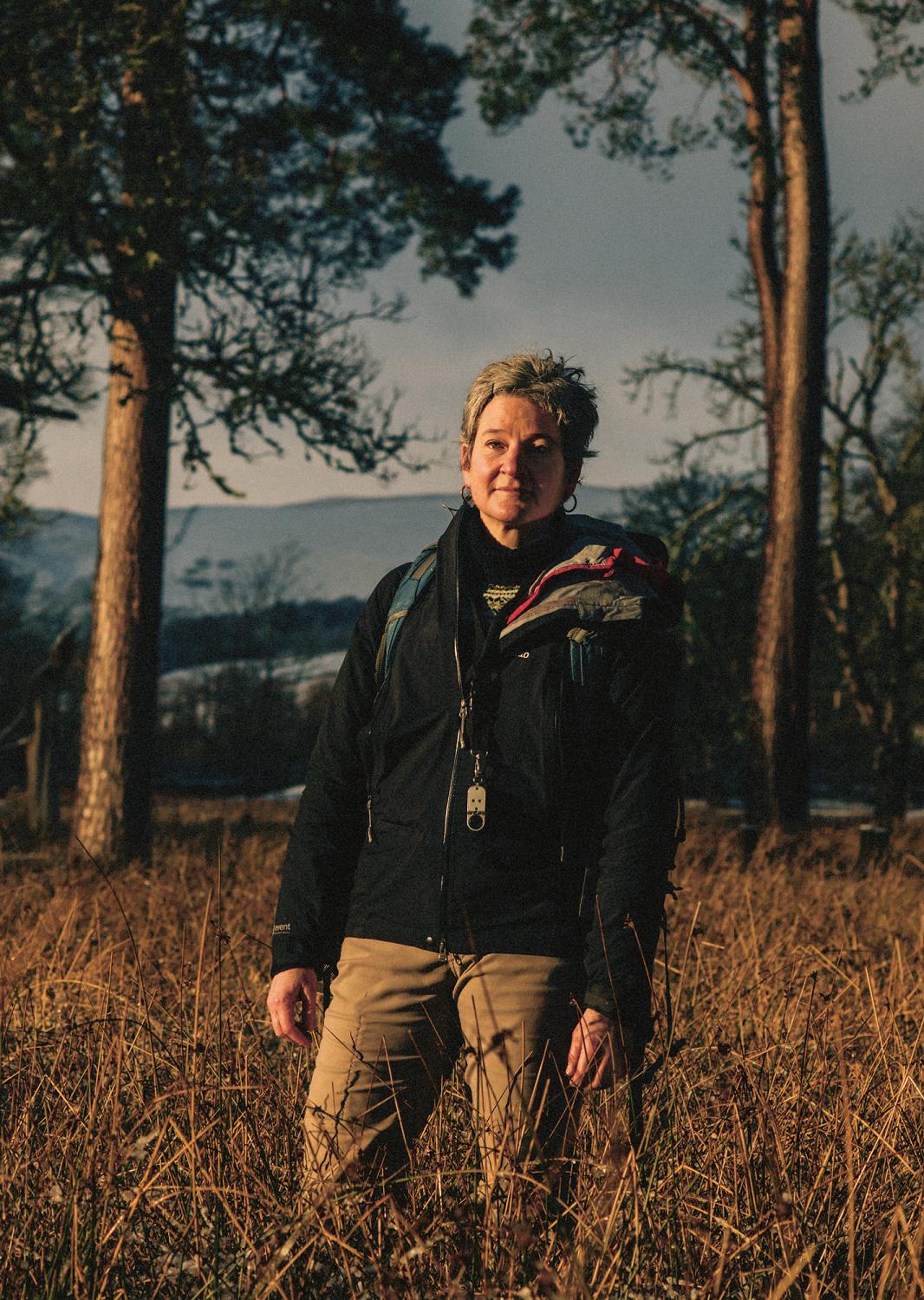
Do look down! The chances are there’s lichen underfoot. That crusty, leafy or bushy stuff has been overlooked and misunderstood for centuries, but it is now identified as a barometer for climate crisis. This is in no small part due to Rebecca Yahr, 50, an American-born botanist now based in Edinburgh, who has spent three decades unearthing thousands of specimens. Time to grab your magnifying lens and hunker down with Rebecca in the field.
There’s a toolkit that Rebecca Yahr takes with her on field trips that sounds more suited to a surgeon, or a sculptor. It contains a couple of carbide-tipped chisels, knee pads and DIY gloves. A sharp fixed-blade knife and a junk knife for soil. A saw. “I’m prepared for every eventuality,” Rebecca – known as Becky – says as we duck to avoid low branches at the Royal Botanic Garden Edinburgh, a majestic, gentle 70-acre hillside of greenery and elegant Victorian glasshouses with views across to Edinburgh Castle. “But it depends on the trip. If I’m going to the top of a mountain, I’m not going to take a saw.”
Fused onto slabs of granite or sprouting in tangles from an ancient oak tree, the objects of Becky’s quests are lichens. She has hunted them in the Colombian tropics, sawing off branches laden with little-known species, and at the top of the snowy Cairngorms. But she also leads “lichen safari” trips for the public around the Botanics, as the gardens are known, explaining to curious visitors that they are neither a sign of decay nor a horticulturalist’s pest. “I often get asked, ‘How do you get rid of it? Is it killing my azaleas?’”
American-born Becky is the lichen biodiversity scientist here, and her role is to identify and conserve these charismatic organisms across the Botanics’ four main sites in Scotland (besides Edinburgh, there are Benmore and its redwoods, the Gulf Stream-warmed garden at Logan, and hilly Dawyck in the Borders) to expand knowledge of them and to flag those in danger via her work for the International Union for Conservation of Nature, which maintains the Red List of Threatened Species. At the same time, she is contributing genetic samples to the Darwin Tree of Life Project, a hugely ambitious 20-year programme that aims to create an inventory of the entire genomes of all animals, plants and fungi in Britain and Ireland.
Lichens, of which about 1,900 species have been identified in the UK, are both familiar by sight and widely misunderstood. On the one hand, they seem indestructible, surviving inside solid rock, in deserts and in the Antarctic. In 2005, Russian scientists blasted a sample into orbit, and it survived for 15 days in the vacuum of space, returning to earth unaffected. Rootless and hardy, lichens have been admired by humans for centuries for their perceived steadfastness. “Of what a strange nature is knowledge!” Mary Shelley wrote in Frankenstein. “It clings to the mind, when it has once seized on it, like a lichen on the rock.”
Yet they are highly vulnerable to the pollution we cause. During the Industrial Revolution they were all but wiped out in the UK. Becky shows me a carpet of springy black dog lichen (Peltigera canina) on rocks in an Alpine garden. These plants’ presence here hasn’t always been guaranteed. In the 1970s, she says, you would have been lucky to spot a lichen in the gardens; now they flourish.
Quite apart from their function as nature’s canary in the coal mine, they are perplexing. A lichen isn’t even a single life form but a combination of loving partners: firstly a fungus, which provides the physical structure, and then, living within it, an alga. In exchange for shelter, the alga offers photosynthesis, making energy for the fungus. To complicate things, sometimes the photosynthesising partner is not an alga but a bacterium, cyanobacterium, and sometimes all three are in the ménage. The word “symbiosis” was coined by the German botanist Albert Bernhard Frank in 1877 specifically to describe lichen. “The symbiosis is at the heart of the matter,” Becky says. “It’s eye-opening once you understand that this is not one thing that you are holding in your hand but two things intimately linked that couldn’t live without each other. That’s how people start to appreciate them. They start to understand just how interlinked things are.”
It is only since the late 19th century that this cosy relationship has been understood. The scrambled-egg-coloured crusty patches you might see on a gravestone and the frothy reindeer lichen that look like dolly-sized shrubs were for centuries ascribed to the world of fungi, a separate kingdom. Carl Linnaeus, the 18th-century genius who invented the system of Latin nomenclature that describes all living things, was unable to comprehend them. “He wasn’t interested in lichens,” Becky says. “He just said, ‘I’m going to let them alone, call it all lichen and be done with it. It wasn’t until [Simon] Schwendener came around in 1867 and had a look inside, saw those little green balls and said, ‘You know, they look a lot like algae, don’t they? This is algae, and this is a symbiosis. Things are working together, and it’s a fundamental aspect of this part of life.’” These days, science can’t get enough of lichens.
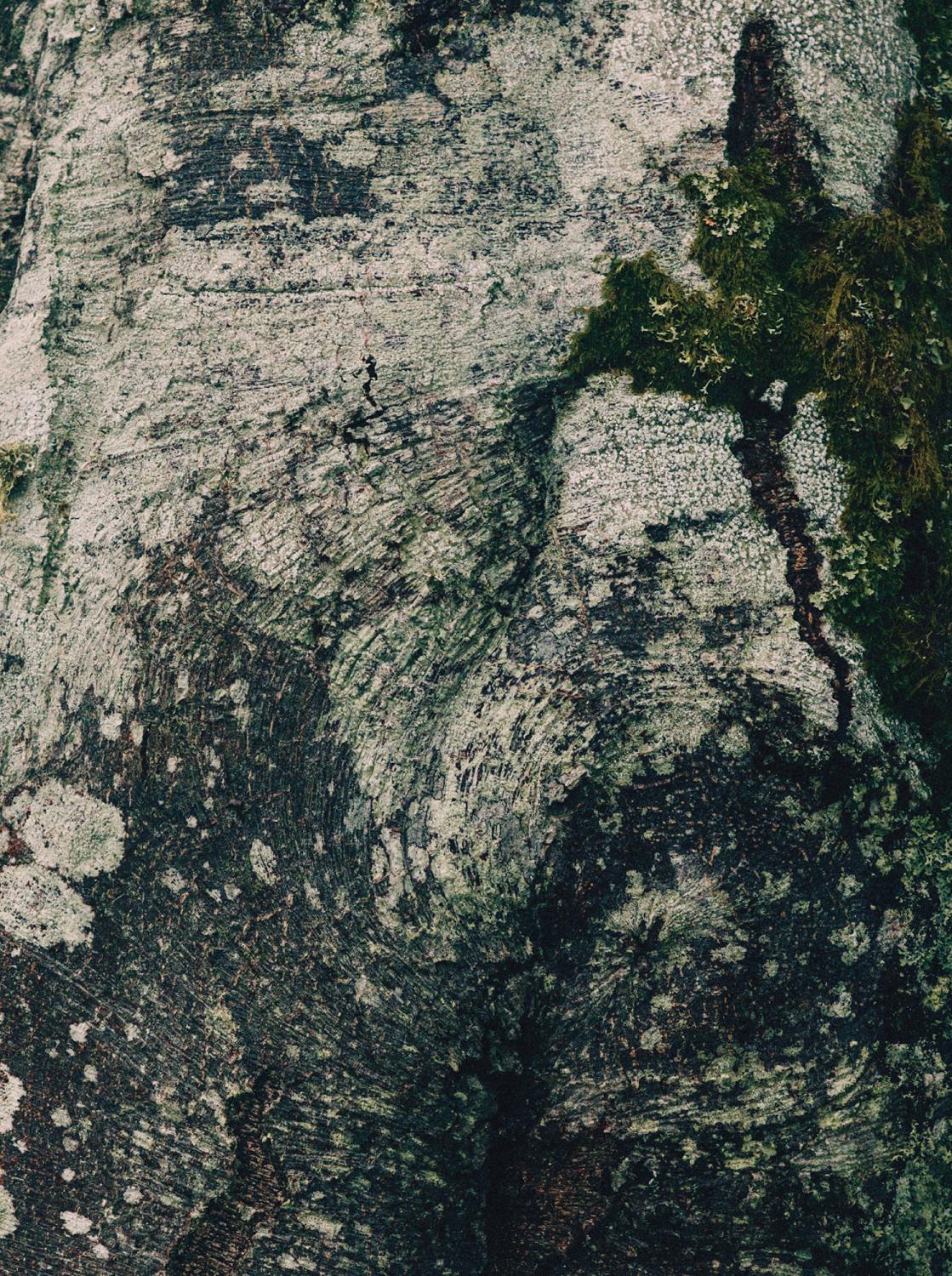
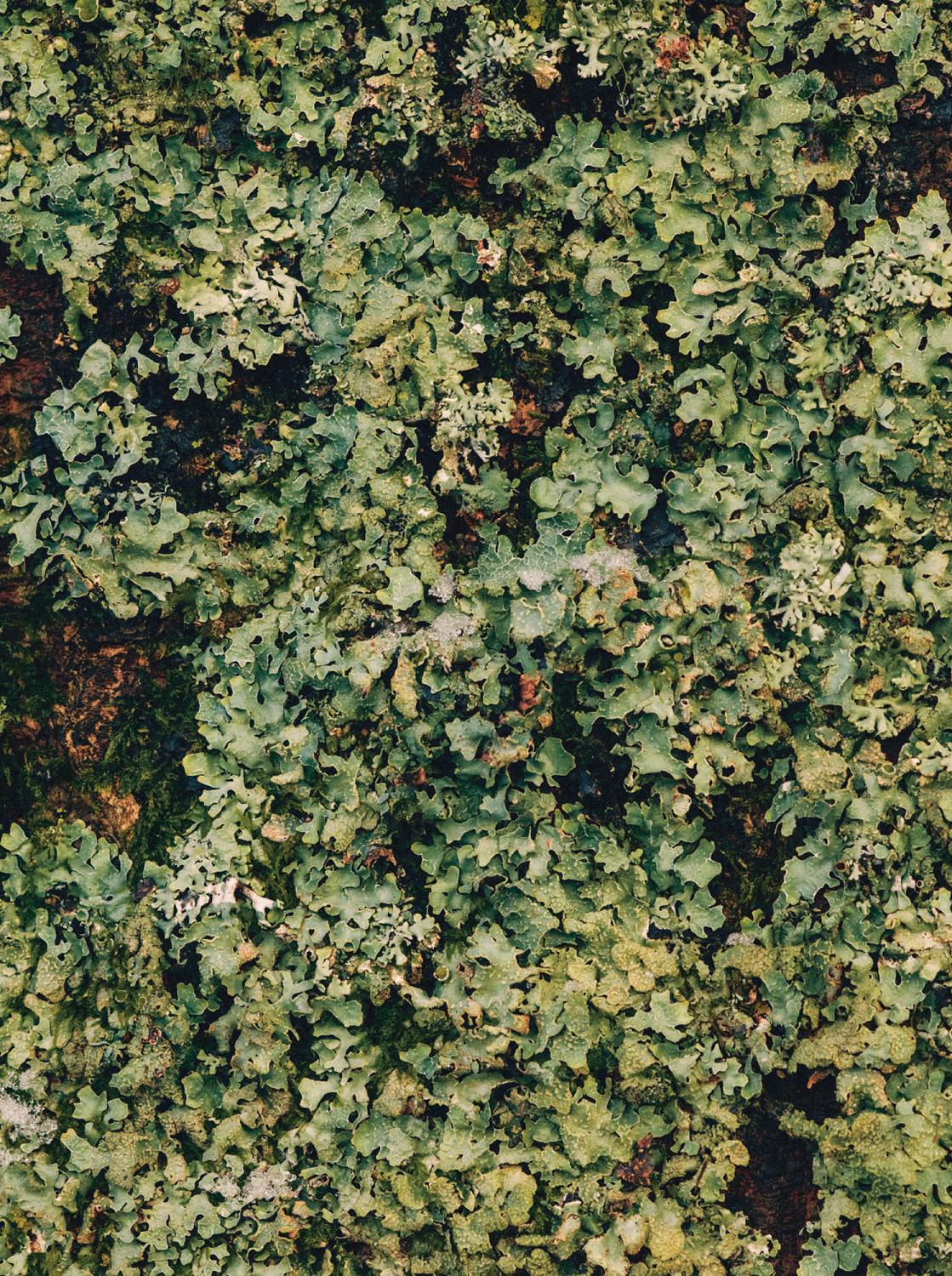
“The so-called oak moss in the previous spread is really a lichen, Evernia prunastri. Until recently, it was harvested in huge quantities and its extract used as a woody, sweet note and fixative in perfumes. It requires fairly clean air and high light, both found among the open-grown whitebeams at Dawyck. The pale grey patches with white speckles on the old beech tree above on the left mark out the characteristic look of the bitter wart lichen, Pertusaria amara. Its second name, amara, refers to the bitter taste of a chemical in the lichen, possibly produced to deter little nibblers (mites, caterpillars and other insects). On the right are the blue-grey lobes of Parmelia sulcata, hammered shield lichen, so named because its fine texture is reminiscent of hammered tin. It is one of the crottle lichens, long used to dye wool, usually resulting in creamy to deep chestnut browns.”
The week before I travel to Edinburgh to meet Becky, I watch a YouTube tutorial she made on how to identify the three main lichen “shapes”. Among her many responsibilities is supervising PhD students, but this clip is a basic lesson: Lichenology 101. Sitting in front of a small blackboard in a room in her home in the north of the city, near Granton Harbour, she patiently explains how to spot the “crusty”, “leafy” and “bushy” varieties, drawing simple diagrams of their structures, pausing to take questions from an invisible online audience. “I had molecular training,” she tells me later, “but I prefer doing something where I use my field skills.” During the video, she explains how to use a small magnifying lens to get up close, as a jeweller might to assess a diamond. That way, it’s possible to see how the complex structures of a lichen resemble corals or jigsaw puzzles or teased wool. Her enthusiasm makes you want to pull on a Patagonia fleece and spend hours lying prone in a cemetery.
Becky says that the recent rise of backyard botany – in part due to the restrictions of the pandemic – has led to a renewed interest in lichens, which are small and accessible. Visitors to the Botanics are curious. “On the safaris, for instance, what we want to do is tell stories. I could just tell you the names of the different lichens, but nobody wants that, right? There are stories, for instance about how sensitive they are to air pollution. Some fix nitrogen from the atmosphere, just like legumes do in the soil. Did you know that lichens do that?”
Communicating with the general public is taken far more seriously by academia now than it was a decade ago. “When I did my PhD in the early 2000s, science communication didn’t exist; it wasn’t a field,” Becky says. “Nowadays, you can’t do a doctorate without actively thinking about how you’re going to communicate it. Public communication is a critical part of what we do. This happened clearly with Covid, right? If we can’t talk about it, then nobody understands what is happening. It’s the same with conservation, with biodiversity, with everything. So we’ve become a bit more savvy about talking about what we do.”
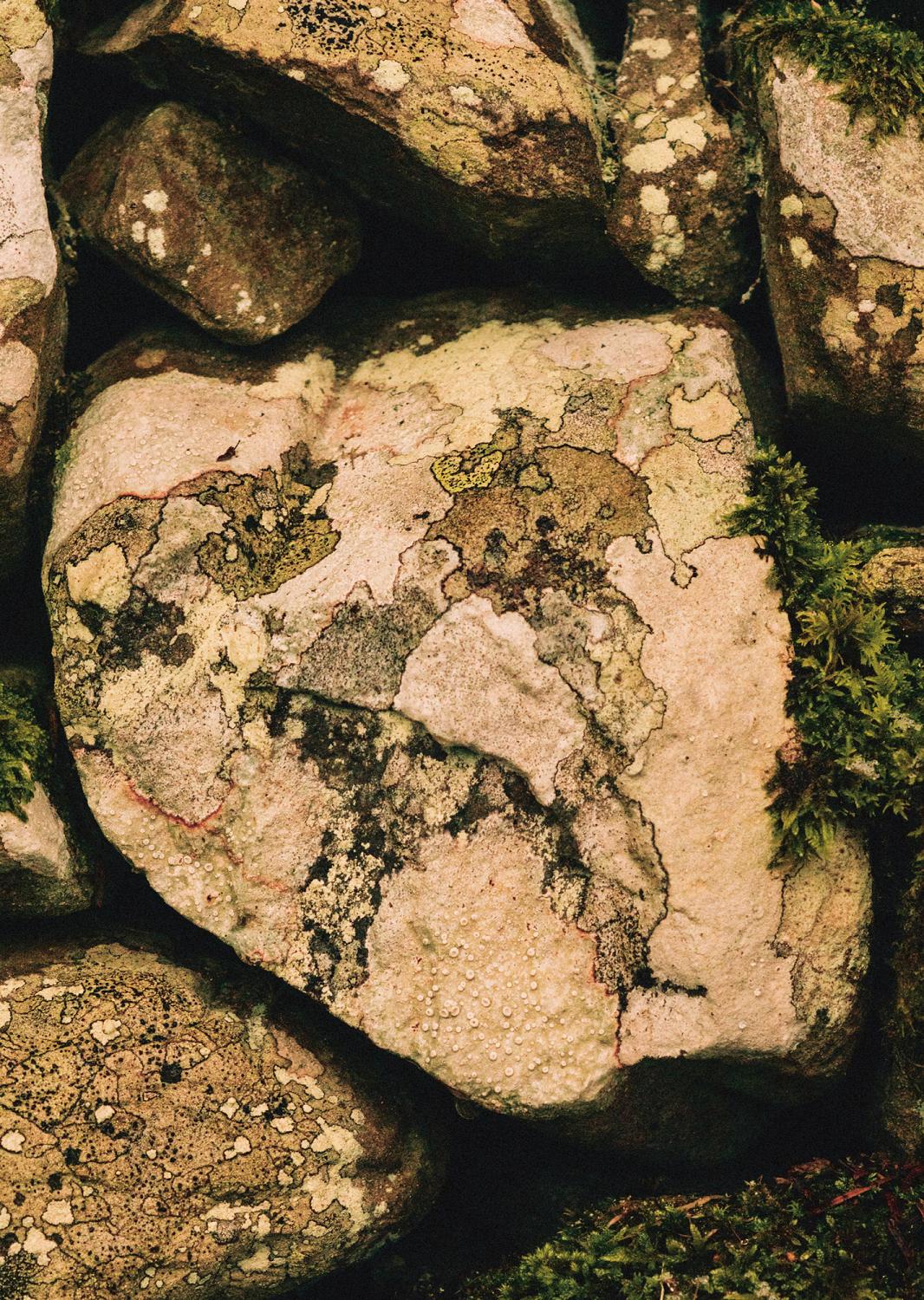
“The heart of stone hosts more than a handful of crust species, from map lichen (Rhizocarpon geographicum), the brilliant chartreuse tiny U-shapes near the top right, to the cudbear near the bottom of the stone (Ochrolechia tartarea). Lichens are made of microscopic threads and can thereby grow in between the grains of a rock. Map lichen can grow five millimetres directly into solid granite.”
If Becky, 50, is a persuasive speaker on her subject, that might be a talent inherited from her late father, Barry Yahr. He was a sales rep for furniture companies, “as was his brother, and his dad had a furniture store. They all had the gift of the gab, and I hope a little of that rubbed off on me.” She grew up in Georgia, in the foothills of the Appalachian Mountains. “Extensive oak, pine and hickory woods” is how she describes the landscape, “third-, fourth- or fifth-growth forest. It’s been cut and cut and cut. There’s nothing special about the forest where I grew up; it just goes on and on.”
Her artist mother, Monica Yahr, is “nature-loving”, and the family took road trips across the USA in their RV, visiting national parks, and 48 states in total by the time Becky was 18. (“I’m missing two: Utah in the lower 48, plus Alaska. We did lots of road trips.”) Meanwhile, her own interest in botany was blossoming, if as yet unidentified. “I used to go down to the river by myself all the time, nominally fishing,” she says. “You know how old guys who fish wear waistcoats with lots of pockets? I had one, and I filled the pockets with field guides, magnifying glasses, tweezers – nerd stuff. Not tackle. I loved fishing, but I was never good at it, and at some point I asked myself, Am I doing this for the fishing or because I like being in the woods and learning all the plants? I was teaching myself botany.”
By the time Becky was an undergraduate at the University of California, Davis, in the 1990s, she was back out into the field, this time in the middle of the desert, to count rare plants in remote locations. Her boss was Maile Neel, a conservation botanist who at that time ran the US Forest Service’s field crew. Becky calls Neel “one of my absolute heroes. She gave me a huge amount of responsibility. She gave us, a group of undergraduates, a truck, a set of keys, a compass and said, ‘Good luck!’ I’m amazed we ever got back from some of those days.” Neel was the person who made Becky realise she was “a Botanist with a capital B. I wasn’t confident in myself until I had that job.” Neel remembers Becky as an “already accomplished field botanist with a commitment to conservation”, she tells me by email. “And through her work now, she has a global impact on the conservation of these critical species, while teaching others how critical they are to our ecosystems. And beyond her technical skills, she was always wise beyond her years. I would follow her anywhere.”
Botany, Becky believes, isn’t one of the areas of science where women are obviously outnumbered. “We have a lot of gay men and a lot of women. There are straight men too, but they’re in the minority. That seems to be the way it is. It’s true that I never struggled with [sexism]. I don’t think I became aware of it until I was doing my PhD; then it became clearer. At that level in the academics, you see fewer women in the authority roles. But in the early steps in botany, I don’t think you run into it so much.”
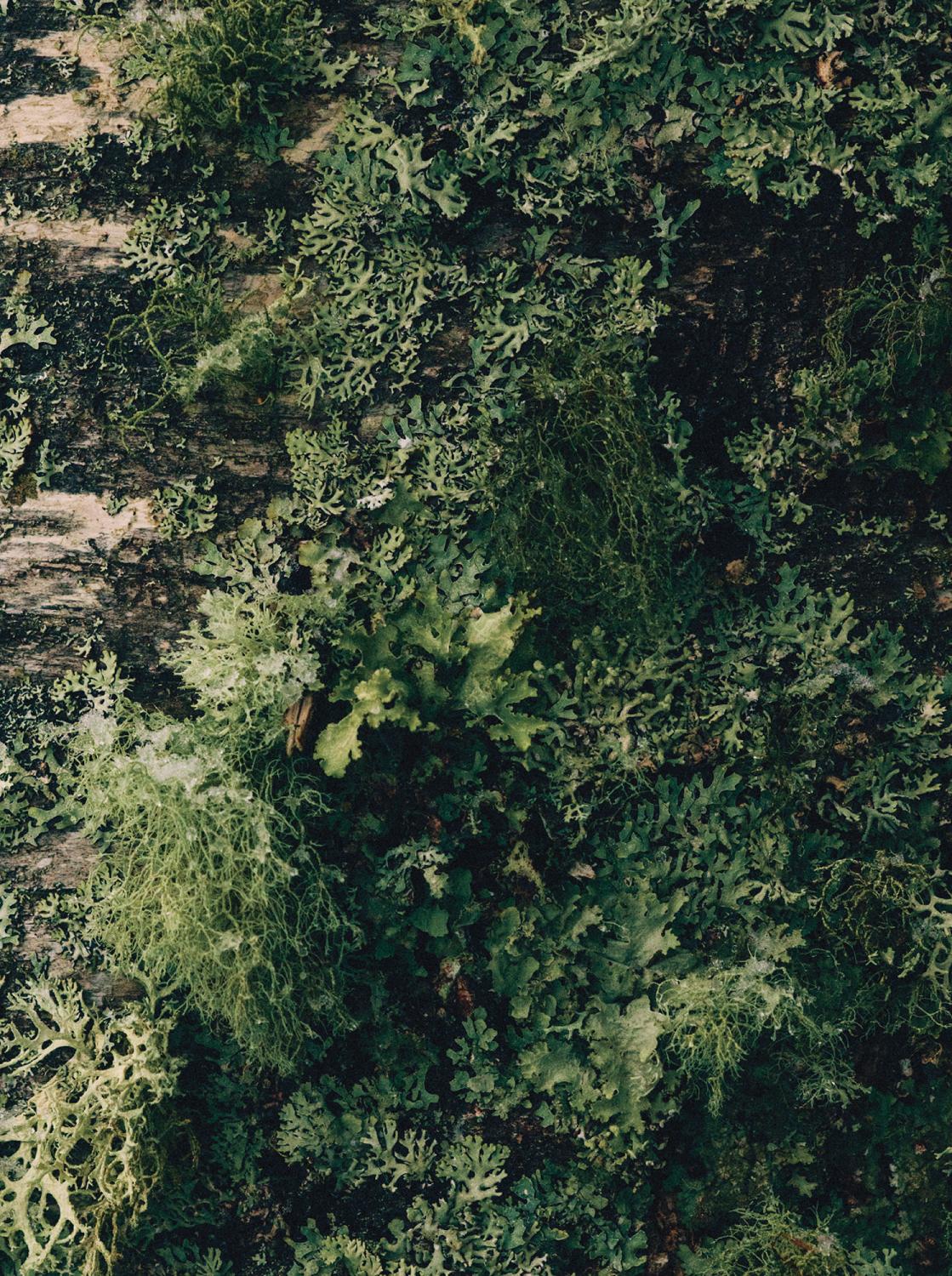
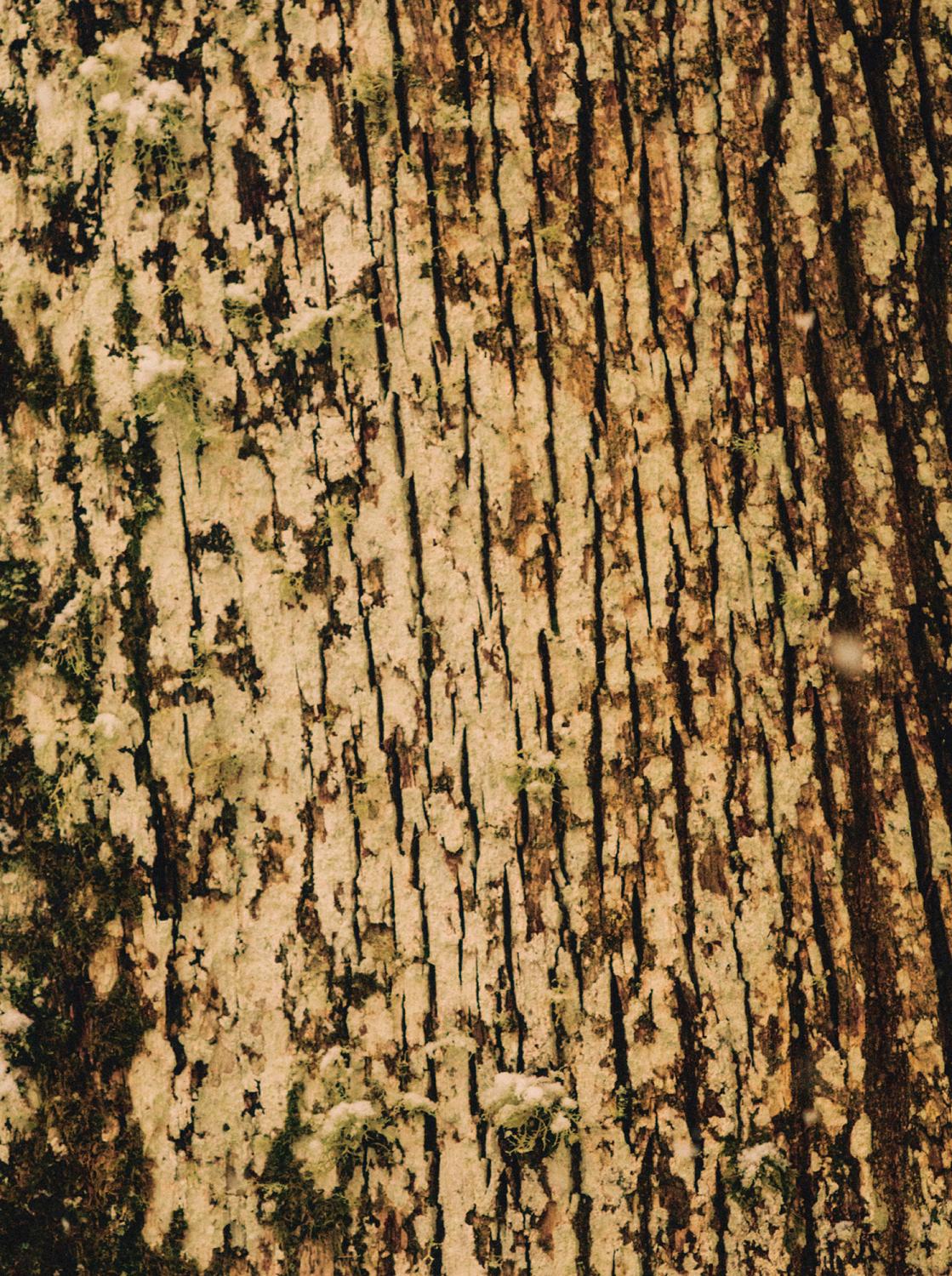
The lichens above on the left are only found in areas with clean air and stable conditions, typical of large parts of Scotland. The fine, hairlike branches of the old man’s beard (Usnea) species are exquisitely sensitive to air quality and won’t grow near sources of pollution. The community on this bark is made of the tiny tubular rosettes of monk’s-hood lichen (Hypogymnia physodes), the large crinkly leaves of curly kale lichen (Platismatia glauca), oak moss (Evernia prunastri), and Usnea species. Two huge oaks grow side by side at Dawyck. The trunks are metres around and, owing to their exceptional longevity, have collected lots of passing bits of lichens over time, from old-wood indicators like Pertusaria hemisphaerica on their dry side to oak moss and the dotted line (Ramalina farinacea) on their shadier, moister sides, pictured above right, contrasting with the bright whitewash lichen (Phlyctis argena).”
Having a certain level of physical courage and being comfortable spending time alone in remote spots is an occupational requirement for the adventurous botanist. “And that’s one of the major things that appealed to me,” Becky admits. “All through my life as a botanist, I’ve run into people with fantastic stories of adventure.” Getting lost is an occupational hazard. “I was once in the Florida scrublands. I’d climbed a fence to see something, and, as botanists do, I was lost in the world of botany, not paying attention to where I’d come from. I stood up and realised I had no idea where I was. It was just scrubland as far as I could see. So I put a stick in the ground, made myself a little sundial and figured out which way south was. It worked.” She laughs. “That’s definitely one of the big draws. But it’s also that, weirdly, there are still so many unknowns. Birds, they’re pretty well known; mammals, really well known. Even for the big organisms of botany, ones that you can actually see, there are still questions remaining.”
Arguably nothing raises more questions than lichens, of which there are thought to be 28,000 different species, some the dominant ground cover in many alpine, Arctic and northern boreal ecosystems. Becky first became captivated by lichens when she was interning at Archbold Biological Station, in the Florida scrub just upstream of the Everglades watershed, in the late 1990s. Growing at the field station was an endangered lichen, Cladonia perforata, which is endemic to Florida. This pale-grey, tufty species was poorly known. “It is quite easy to identify, but most folks don’t notice lichens,” Becky says.
“I took it upon myself to try to understand it,” she adds. “I think it was the profound lack of information at a basic level that intrigued me. It is beautiful but overlooked, and was misunderstood by even the best field biologists I knew.” She studied how Cladonia perforata could be transplanted and recover from fire, which is hugely important in Florida ecosystems, and from hurricane damage, because a huge hurricane had hit the Florida panhandle not long before. “It was exciting to think I could make a small contribution to that body of natural-history knowledge.”
By the mid-2000s Becky had completed a PhD investigating how the mutually beneficial relationship between fungi and algae in lichens evolves over time. “How does it change, and what drives that partnership? Which was really interesting and very novel.” She had met her Scottish husband, Chris Ellis, an ecologist working mostly on lichens, at the 7th International Mycological Congress in Oslo in 2002, and took up a post at the Botanics four years later. They now live a bike ride from the gardens with their two children. “It was a bit of a shock to the system,” she says of her transplantation from the southern US to Edinburgh. “We’re at 56 degrees north here, and the furthest north I’d lived was 36 degrees. It’s a massive difference latitudinally. But the long summer days and nights here are incredible; they’re worth it.”
Of course, it helped that Scotland is host to 1,500 lichens, including hundreds of internationally important species. Most precious among the habitats here is the Scottish rainforest – native woodland found on the country’s west coast with consistent rainfall and milder temperatures – where trees drip with lichens. “It’s one of our most important habitats in the UK from a conservation point of view,” Becky says. “From a lichen point of view, it’s definitely the most important. The appreciation of the rainforest was something that actually started here at the Botanics, with my predecessor. They started researching the lichens out there and realised that this stuff is important on an international scale. Not just for Scotland, not just for the UK – it’s important for Europe and the world. It’s a really rare habitat, and we have the best examples of it in all of Europe.”
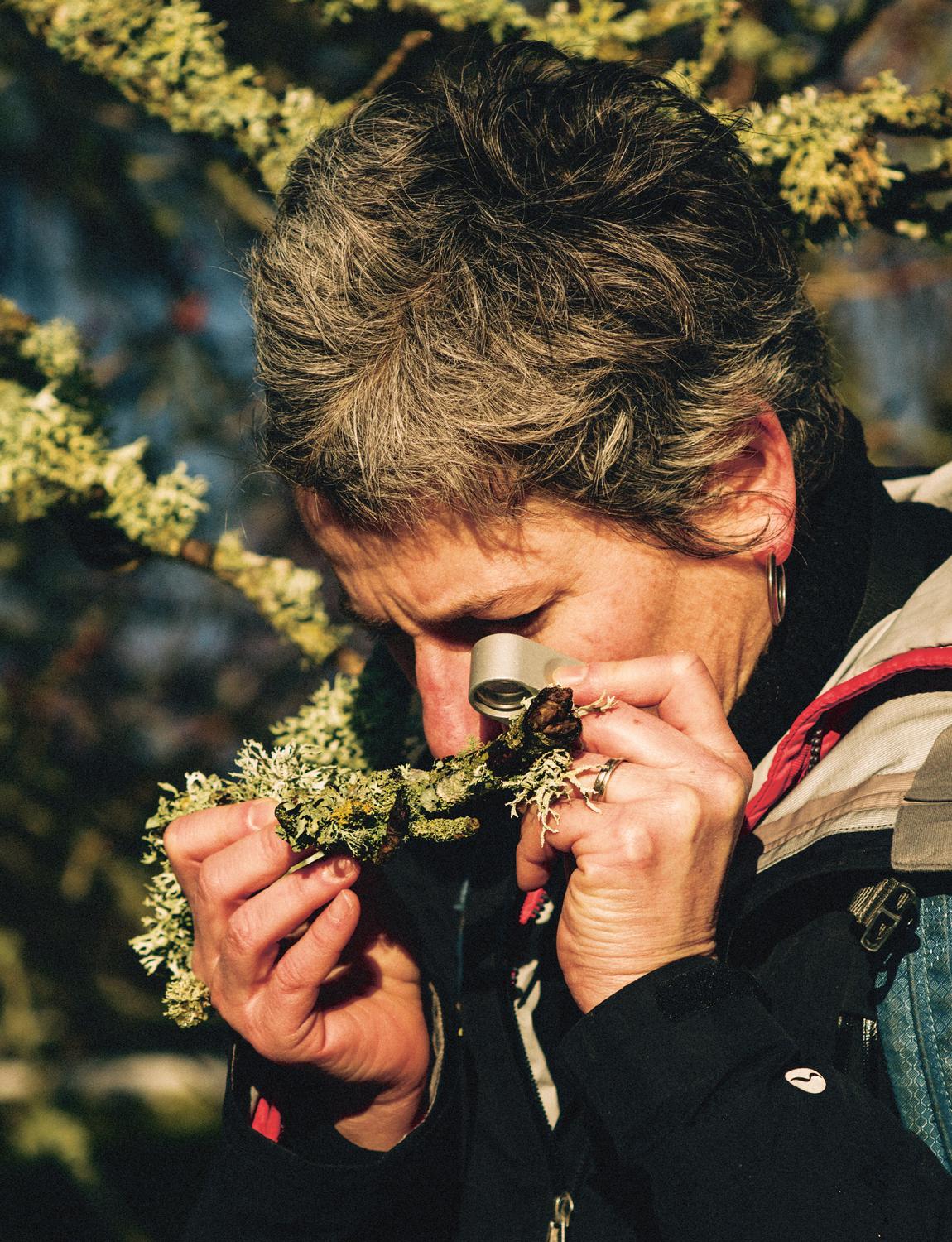
“When you see a fairy glen of lichens, you realise, OK, the air here is good. I’m healthy, these guys are surviving.”
In January, the warmest place at the Botanics is probably one of the famed Victorian glasshouses where subtropical species grow, but the driest might well be the herbarium. Home to a vast research collection and not open to the public, it is found within the 1960s building where Becky also has her office (neat, book-stacked, with watercolours of lichens pinned to the wall behind her computer) and lab.
The dim and silent herbarium has a botanical archive of 3 million dried plants and fungi. Three of the banks of cupboards are dedicated to lichens. Each specimen is stored in a paper packet and labelled by hand with the genus and species and the name of the botanist who collected it. Some are sent in as gifts or in exchanges with other herbaria. I ask to see oak moss (Evernia prunastri), the lichen used in perfumery, although to my disappointment I can’t detect the smell. “Some people’s noses can’t recognise that molecule,” Becky commiserates.
She then shows me a crisp specimen, still attached to a piece of bark, collected by her predecessor at the Botanics, the lichenologist Brian Coppins, a world authority on crustose lichens. Now Becky is adding to the archive, although she’s too modest to show me the lichen that she helped name – Opegrapha viridipruinosa Coppins & R Yahr was collected by Coppins and described by Becky. A second lichen, Gyalectidium yahriae WR Buck & Sérus., not found in Edinburgh, was named after Becky in a nod to her collection of that species’ “type” – the single specimen a scientific name is forever attached to. “It was totally unnecessary, but really kind,” she says. You can see Gyalectidium yahriae in the New York Botanical Garden collection – “a very inconspicuous little greenish crust, but it has very unusual crown-shaped spore-bearing structures,” Becky says. “Only visible with a 10x lens, though.”
Along the corridor from the herbarium is the microscopy lab where most of Becky’s DNA work is done. The Darwin Tree of Life programme is perhaps the most ambitious project she is working on. In April, she and her partner botanists – equipped with field kits and those ubiquitous paper packets – will travel up to Beinn Eighe, a mountainous nature reserve in the Highlands of Scotland. “We’ll collect lots and lots of things. Lichens, but a lot of insects and plants, too.” The aim of the Tree of Life project is to sequence the genomes of all animals, plants, fungi and protozoa in the UK in the hope of understanding evolutionary history and informing medicine, agriculture and conservation in the future. The project’s leader, Mark Blaxter, tells me by email that understanding lichens is the major biological challenge. “How and why do two (or more) very different organisms come together to make something very new and very successful? Lichens make a wide range of ‘new’ chemicals. Excitingly, these may be unique products of the between-species cooperation that only happens inside the lichen, and they may be the source of new drugs.”
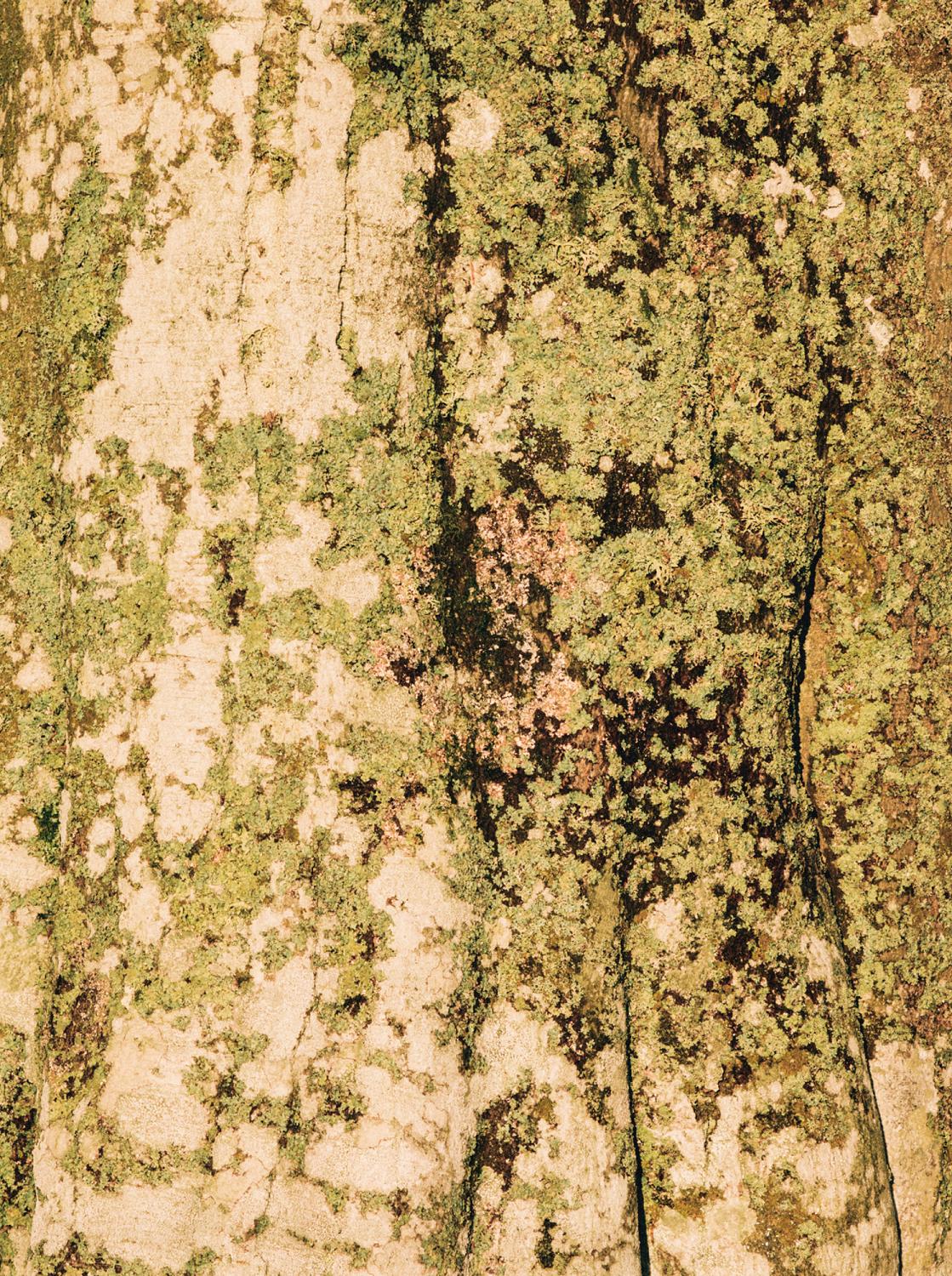
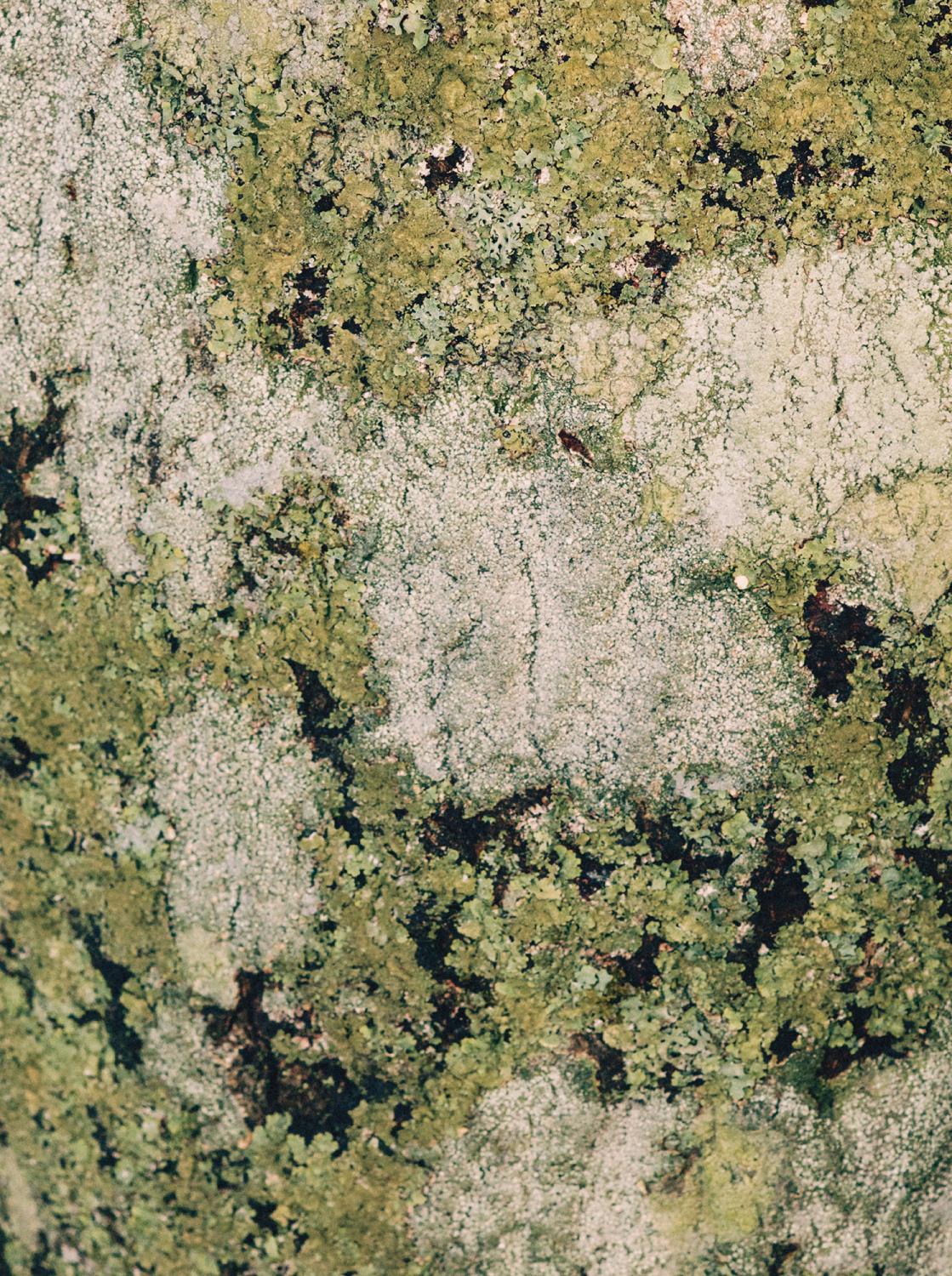
“The old tree on the left shows one of lichen’s important ecological roles — as food for other creatures. The pinkish patch in the middle is dying lichen, being eaten by parasitic fungi. The old bark of the oak on the right is home to fierce conflict between the cudbears and the crottles: the golden saucer lichen (Ochrolechia androgyna) and the salted shield lichen (Parmelia saxatilis). Though lichen communities look static, slow battles are played out over space and access to light.”
“We’re trying to catalogue life” is how Becky describes it. “We’re going to have the whole encyclopedia, and you’ll be able to open those pages and read all about it. It’s nice to think about that, because a genome is kind of abstract. I mean, what is it? But when we have a genome, it allows us to interrogate the biology of the species, to understand how it works.” Specifically, to better comprehend living things like lichens. “How does it work with its symbiont? How does it work with the environment? How is it sensitive to salt, and why is it sensitive to climate change? What are the parts of the puzzle? All of the parts of the puzzle are just laid bare when you have the genome.”
But if lichens are mysterious to the most eminent botanists, they certainly remain enigmatic for those of us who only have the naked eye, or even a magnifying glass, to examine them. For instance, for what purpose do some have bright colours or attractive patterns, such as red Baton Rouge, Cryptothecia rubrocincta? “That group has a lot of red pigments in it, special to that lineage,” Becky says. “But you know, we don’t know why the colours are as they are. The bottom line is, in evolution, if it’s here now, it’s because it works, for whatever reason. It’s a great mystery. There are so many open questions about lichens,” she adds, happily.
For anyone who is what the celebrity mycologist Merlin Sheldrake has called “lichen-curious”, the most basic tool you will need in your field kit is a hand lens. Becky has a superior one, crafted in Switzerland by a retired physicist, with powerful magnification and two LED lights; it arrived engraved with her name – a mistake, she says, as it was supposed to be a gift for her husband. But a good-enough lens is yours for a couple of pounds. It’s a low price for the chance to pass through a portal into a miniature world where an entity can both be one thing – a lichen – and an entire eco-system at once.
Even just spotting lichen with the naked eye on a casual walk should lift our spirits, Becky says. “When you see a fairy glen of lichens and you know that these guys are sensitive to air pollution, it just makes you want to breathe deeply.” She pauses to inhale. “And you realise, OK, the air here is good, right? I’m healthy, these guys are surviving, it’s good.”

These photographs were taken at the Dawyck Botanic Garden in the upper Tweed Valley in the Scottish Borders. The area’s steady climate has proved ideal for growing plants from across the globe, including specimens from Nepal, Chile and Japan. Visitors to the gardens should be sure to admire the Himalayan blue poppies that bloom throughout the summer months (after inspecting the lichen).
Susie RushtonA writer and editor living in London, Susie currently serves (for she loves tennis) as the deputy editor of the Telegraph Magazine. Previously, she was the features editor at British Vogue, the deputy editor of Porter and the editor of The Independent Magazine. Susie is also a champion fencer; her weapon…read more Photography by
Robbie LawrenceRobbie Lawrence is a Scottish photographer born in Edinburgh and now based in London. An English Literature graduate of the University of St. Andrews, initially Robbie pursued a career in journalism, with a Photo Editor traineeship at The New York Times in Paris, before picking up a camera. Among his…read more